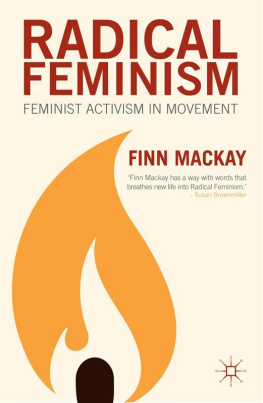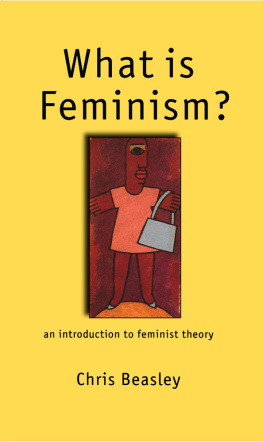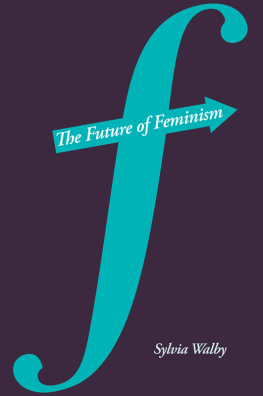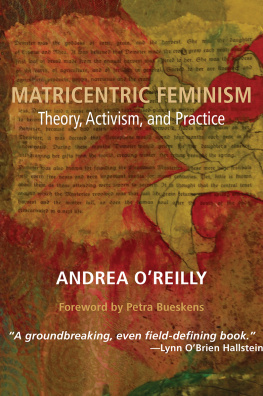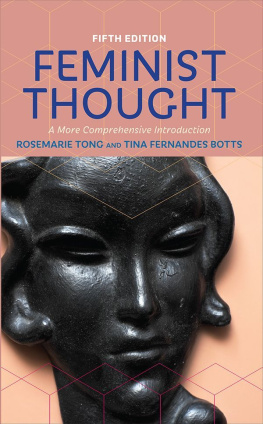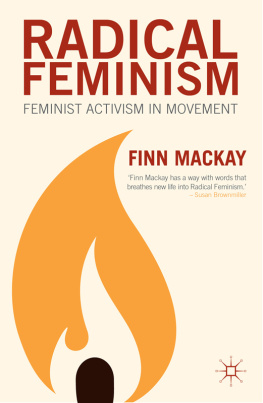Radical Feminism
Radical Feminism
Feminist Activism in Movement
Finn Mackay
University of the West of England, UK


Finn Mackay 2015
All rights reserved. No reproduction, copy or transmission of this publication may be made without written permission.
No portion of this publication may be reproduced, copied or transmitted save with written permission or in accordance with the provisions of the Copyright, Designs and Patents Act 1988, or under the terms of any licence permitting limited copying issued by the Copyright Licensing Agency, Saffron House, 610 Kirby Street, London EC1N 8TS.
Any person who does any unauthorized act in relation to this publication may be liable to criminal prosecution and civil claims for damages.
The author has asserted her right to be identified as the author of this work in accordance with the Copyright, Designs and Patents Act 1988.
First published 2015 by
PALGRAVE MACMILLAN
Palgrave Macmillan in the UK is an imprint of Macmillan Publishers Limited, registered in England, company number 785998, of Houndmills, Basingstoke, Hampshire RG21 6XS.
Palgrave Macmillan in the US is a division of St Martins Press LLC, 175 Fifth Avenue, New York, NY 10010.
Palgrave Macmillan is the global academic imprint of the above companies and has companies and representatives throughout the world.
Palgrave and Macmillan are registered trademarks in the United States, the United Kingdom, Europe and other countries.
ISBN 9781137363572
This book is printed on paper suitable for recycling and made from fully managed and sustained forest sources. Logging, pulping and manufacturing processes are expected to conform to the environmental regulations of the country of origin.
A catalogue record for this book is available from the British Library.
A catalog record for this book is available from the Library of Congress.
This book is dedicated to:
My precious grandma, Margaret Walker (19242005),
to whom I owe everything
My friend and academic colleague
Jo Scamell MSc (19602011), a woman who walked
the walk as well as talked the talk
Contents
Acknowledgements
I would like to thank my editor Andrew James at Palgrave for always being enthusiastic and honest; the team have been really helpful through the process of writing this book. All the people I have met at feminist conferences and events, as well as the students I have taught, have helped me by asking questions and by presenting challenges for feminist theory; I have tried to answer some of them here. I owe thanks and gratitude to all the activists who took time to be interviewed in my research. I would also like to thank Eaves Housing for Women and Isobel, who said go for it in 2004. Becca Morden and all the women on the Reclaim the Night Organising Committees past and present are due great thanks for their tireless activism and abilities to get things done. I thank all those Amazon women who I have marched alongside in the London Feminist Network and the London Reclaim the Night (RTN). Some of those women are no longer with us and are sadly missed; in particular, I take this opportunity to remember the work of warrior woman and genuine Amazon, Claudia Da Silva (19482012), founder of the London Centre for Personal Safety who provided feminist self-defence at our Feminism in London Conferences. Thanks are due to the inspiring activists named in this book, founders of the original UK RTN Al Garthwaite and Sandra McNeill. I am blessed and proud to call them friends, sisters and comrades. Greenham Women and Peace Women everywhere have also been part of my feminist journey, and in particular, I owe a debt to one of the founders of Greenham Common, Helen John, who has always been an inspiration. The University of the West of England provided me with an office while I completed the book and thanks are due to all my colleagues in the sociology department. Last, but not least, thanks are due to my wife, Rosie Buckland, who read several drafts and gave invaluable suggestions, and also my cat Isambard, who regularly sat on the manuscript and provided a welcome distraction.
Finally, thanks to the women who provided endorsements and reviews of the book. I am truly humbled and honoured.
The latter section of this book on how to organise an RTN march started life originally as a blog. Sections of were developed from an article originally published in the Womens Studies International Forum (2014), 44, pp. 4654. ISSN 0277-5395 and are reproduced with permission from Elsevier.
Chapter 1
Introduction: Why march through this book?
The beginning
In the midst of the Cold War, in a divided country, feminists were about to start a global movement that for decades to come would unite women in symbolic protest against male violence against women. Shortly before midnight on 30 April 1977, small groups of women began gathering in the centre of towns and cities across West Germany: Bochum, Frankfurt, Cologne, Hanau. They were dressed as witches, carried flaming torches and had painted womens symbols on their faces. The date of their synchronised protest was no accident. They were assembling on that night to mark what is still known across Germany as Walpurgis Night, a superstitious tradition to mark the coming of May; a time when witches and tricksters are believed to roam.
But that year, it was women who took back their streets on that dark night; on the stroke of the witching hour, women roamed freely in riotous processions down avenues and through parks where, on their own, they would have felt unsafe. They danced and laughed in city squares, and they pelted men who got in their way with flour bombs and with water pistols loaded with dye. They sang songs and chanted: we are not pieces of meat; we are not here to be leered at, grabbed at and abused; we are not cattle to be looked over by male eyes. They were protesting against sexual harassment, loudly voicing their anger against rape and all forms of sexual violence against women; they reclaimed the night to highlight how rarely they could. Men beware, they chorused, now the night belongs to women.
Those women started a movement that night; with the light of their flaming torches they passed on a tradition that has marched all over the world and which is still inspiring and empowering women everywhere to this day. The protest they popularised is called Reclaim the Night (RTN) across Europe and Asia and Take Back the Night in Canada and America. This is a book about the path that protest has taken, about how it has changed from that day to this and what that process means for the contemporary Womens Liberation Movement (WLM). It is a book about feminist activism, specifically feminist activism against male violence against women. It will speak to activists who are involved in the Womens Movement today; indeed, it will speak to anyone who believes in the urgency of change for women and who wants to think about how we might make that happen.
What is feminism?
This book is in part about history; but it is also a book about our future. Not just a future for women, but also a future for all of us; a future that is more just and equitable, a future full of hope. It is my contention that feminist theory and politics contain answers that can help us get to that destination; I will try to prove this in the chapters to come. In particular, I will be exploring the politics and theory from the time known as the Second Wave of feminism and particularly from influential American and British theorists. This is the period, from the late 1960s through to the 1980s, when feminism is last considered to have been at its height in the West. It was named the Second Wave because it was seen to follow on from a First Wave of feminism, the previous recognised upsurge of feminist activity during the 1800s and 1900s, most renowned for the activism of the Suffragettes.
Next page
